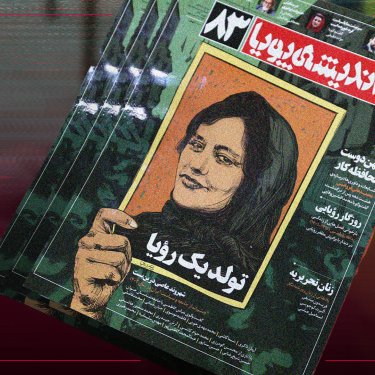Iran has arrested 79 journalists in a staggering crackdown since Mahsa Amini’s death a year ago

Updates on 15/09/2023: According to new information verified by RSF, journalist Nazila Maroufian was released on bail on September 9, 2023 after appealing her conviction, and journalist Farzaneh Yahyaabadi has been out on bail since October 2022, after being severely assaulted during her interrogation. This brings the total number of women journalists arrested after September and still in detention to three.
Reporters Without Borders (RSF) looks back at the Iranian government’s year long crackdown on journalists for covering the wave of protests triggered by Mahsa Amini’s death in police custody – 12 months of arbitrary arrests and trials on spurious charges. A labyrinth of state repression that saw a total of 79 journalists arrested,12 of whom remain in prison to this day. As for those who have been released, their freedom remains restricted.
It begins with an arrest and then an interrogation. A reporter is arrested during a protest. Another journalist is handcuffed during a violent raid on his home. A third is arrested in a swoop on his office. The reasons for arresting 79 journalists since the young Kurdish student’s death in police custody on 16 September 2022 are often unclear, but the main charge is always the same – “anti-state propaganda.” As a bonus, aggravating circumstances are often added, such as “prohibited assembly,” “collusion against state security” and even “collaboration with a hostile country." Of the 24 journalists currently imprisoned in Iran, 12 were arrested after the Mahsa Amini protests began.
Once detained, most of these journalists find themselves trapped in the dark corridors of Iranian justice. Physical and psychological violence, judicial corruption and bureaucratic dysfunction combine to lock them in a labyrinth of repression. Journalists sometimes simply disappear for hours before their loved ones learn that they were placed in solitary confinement. When a hearing is set, the date can be announced and then canceled, held without notifying the journalists' lawyers, or notifying them only at the last minute. Processes are obscured, everything is blurred.
“No single set of rules dictates what can and cannot be said in the media,” an Iranian journalist told RSF on condition of anonymity. “If there were clear rules, we would know how to get around them. The authorities are smart enough to understand that. Everything is arbitrary, therefore everything is forbidden.”
“Despite its complexity, this labyrinth of repression designed by the Iranian authorities to persecute journalists comes down to a very simple formula – either reporters censor themselves or they are locked up. The continued arrests are a testament to the fact that some journalists continue to defy this formula. We urge the Iranian authorities to stop prosecuting them, to remove the obstacles that hamper the media, and to release the 12 journalists detained since the start of the protests, as well as all the imprisoned journalists.”
The Iranian authorities are also tightening their grip on journalists by increasing the number of suspended sentences or tightening the conditions for release. Of the 79 journalists arrested since the start of the protests, 24 have been sentenced to between six months and six years in prison for “anti-state propaganda” (among other charges). If most of them remain outside prison, it’s because they were either granted illusory clemency in a wave of amnesties in January, benefited from suspended sentence, or are in an endless wait for an execution of their sanction. Judges often suspend sentences for a fixed period, reserving the right to implement them if the journalist commits another “crime.” They thus exercise a form of long-term censorship and surveillance. Some journalists are spared imprisonment but they are often prohibited, including those released on bail, from leaving the country, practicing journalism and from speaking to the media. By imposing a permanent fear of punishment, Iran silences its journalists.
Even journalists living abroad have a permanent threat hanging over them. They often receive threats from the authorities, who sometimes go so far as to arbitrarily detain close relatives still living in Iran. This is what happened to Shima Shahrabi, the editor of the Persian-language news site Iran Wire. After she fled the country, her brother, the radio journalist Sajjad Shahrabi, was arrested in Iran in May 2023, was interrogated about his sister's work, and was imprisoned for more than a month.
One of the biggest jailers of women journalists
The authorities have paid particular attention to women journalists who have been covering the “Women-Life-Freedom” protest movement that followed Mahsa Amini’s death. According to RSF’s tally, of the 79 journalists arrested during the past year, 31 have been women. Iran has thereby become one of the world’s biggest jailers of women journalists
Five of these 31 women journalists are still in prison. Without these journalists, the coverage of the “Woman-Life-Freedom” movement would not have been the same. They include Shargh Daily reporter Niloofar Hamedi, who is the journalist who told the world that Amini had just died in hospital after several days in police custody. They also include Han Mihan reporter Elaheh Mohammadi, the only journalist to cover Amini’s funeral in Saqqez, in Iran’s Kurdistan province. Both are still awaiting a verdict in their trials on serious charges.
Nazila Maroufian, the Rouydad24 journalist who was pardoned on 28 January shortly after receiving a two-year prison sentence for interviewing Amini’s father, was arrested again on 30 August and was quickly sentenced to a year in prison for “publishing propaganda.” She reported that she was sexually assaulted when arrested.
Freelancer Farzaneh Yahya-Abadi has been detained provisionally since her arrest on 19 October for covering protests in Abadan, in Khuzestan province, while another freelancer, Vida Rabbani, has been serving a six-year sentence since 22 September 2022. She was convicted of “meeting and colluding against state security” as well as “anti-state propaganda.”
Iran is ranked 177th out of 180 countries in RSF's 2020 World Press Freedom Index.
